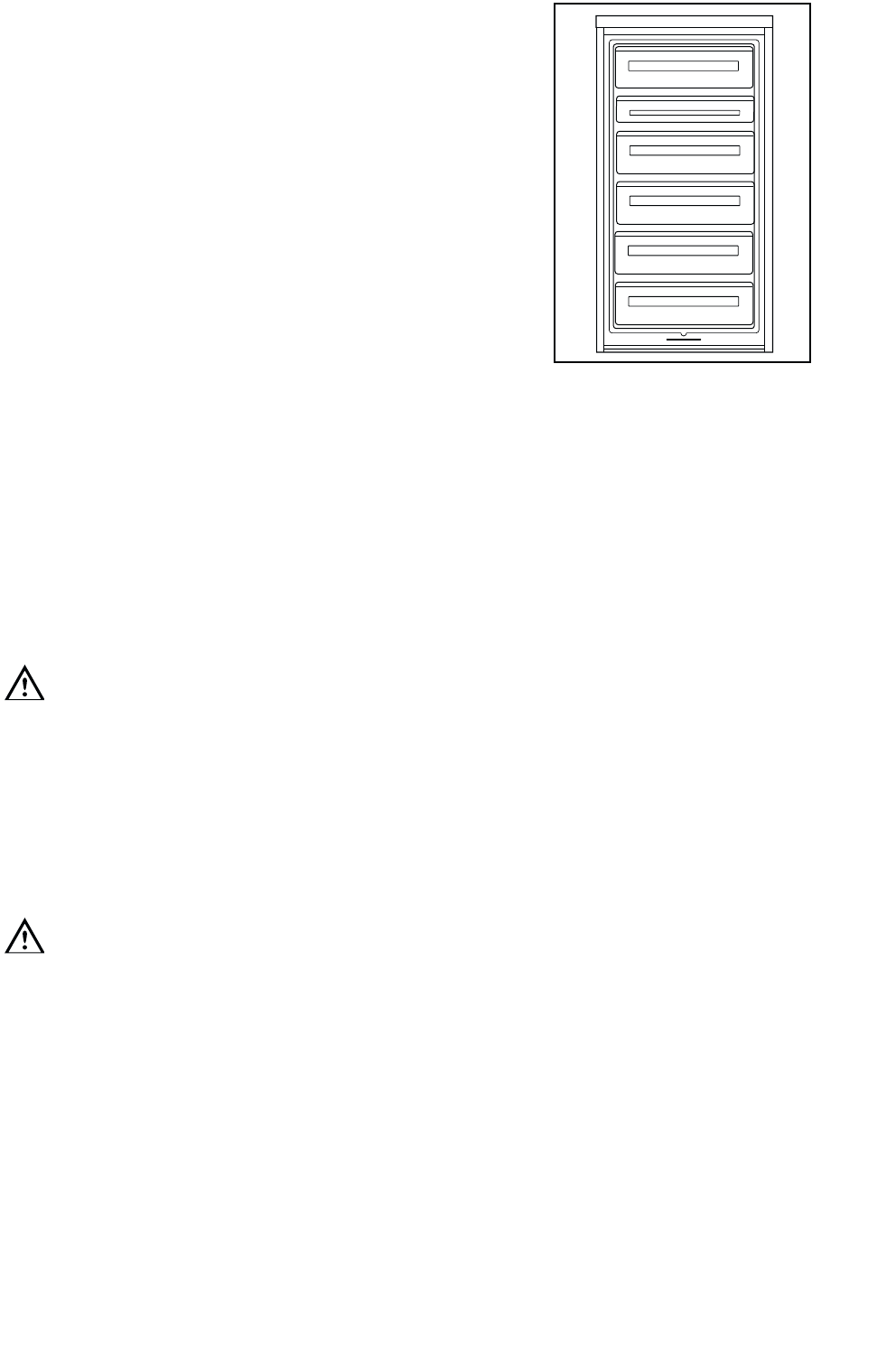
5
In order to freeze the quantity indicated on the rating
plate, arrange the food directly in contact with the
cooling surfaces. If the food is frozen in the baskets,
the maximum quantity that can be frozen is slightly
less.
Once the food is completely frozen (which could take
up to 24 hours) return the fast freeze switch to the
«N» position; the yellow light (D) goes off.
Distribute the frozen food packages in the other
compartments, so that the fast freeze compartments
can be used for a further freezing operation.
- The food to be frozen must be fresh and of the
best quality.
- Do not allow fresh food to touch food which is
already frozen.
- During the freezing process, ensure that the
freezer door remains closed.
Frozen food storage
When you first start the freezer or if the freezer has
been out of use for some time, we advise you to run
your appliance for at least two hours in the «fast
freeze» mode before storing frozen food.
Do not exceed the storage period indicated by the
manufacturer.
Finally, do not open the door frequently or leave it
open longer than is absolutely necessary.
Important
Do not put carbonated liquids, (fizzy drinks etc.), in
the freezer compartment.
Ice Iollies, if consumed immediately after removal
from the freezer, can possibly result in a low
temperature skin burn.
Do not remove items from the freezer if your hands
are damp/wet, as this could cause skin abrasions or
“frost/freezer burns”.
Important
In the event of a power cut do not open the door. The
food in the freezer will not be affected if the power
cut is short and if the freezer is full. Should the food
begin to thaw, it must be consumed quickly and must
not be re-frozen.
Making ice cubes
The appliance is provided with one or more plastic
ice cube trays.
Fill the tray(s) 3/4 full to give the ice space to expand
and place them in one of the freezer compartment.
To release the ice cubes simply give the tray a slight
twist. Do not use sharp or metallic instruments to
remove the trays from the freezer.
Thawing
Frozen food, prior to being used, can be thawed in
the fridge or at room temperature depending on the
time available. Small food items may even be cooked
from frozen; in this case cooking will take longer.
Any frozen food which is allowed to thaw accidentally
should either be eaten as soon as possible or thrown
away. Alternatively, if the food is uncooked and has
not been completely defrosted it can be cooked and
then refrozen.
Meat, fish and fruit should be thawed in the
refrigerator compartment and small pieces of meat
can even be cooked while still frozen, but you must
ensure that it is thoroughly cooked through.
Vegetables should be directly immersed in boiling
water; ready-cooked dishes can be placed directly in
the oven in their aluminium wrapping.
A microwave oven is particularly suitable for thawing
any type of frozen or deep-frozen food: follow the
oven instructions, particularly regarding the
placement of aluminium wrapping or containers in
the oven.
Defrosted cooked food must never be refrozen.
PR176/1
10 kg
10 kg
12
INSTALLATION
Positioning
This appliance should only be installed at a location
where the ambient temperature corresponds to the
climate classification indicated on the rating plate,
which is located at the left on the inside of the
appliance.
The following table shows which ambient
temperature is correct for each climate classification:
SN +10°C to + 32°C
N +16°C to + 32°C
ST +18°C to + 38°C
T +18°C to + 43°C
It should be located in a dry atmosphere, out of
direct sunlight and away from extreme temperature
e.g. not next to a boiler or radiator, or in a very cold
room e.g. an outhouse, where the temperatures may
fall below 10°C (50°F). If these temperatures are
exceeded i.e. colder or warmer, then the appliance
may not operate correctly.
You should also ensure that air can circulate freely
around the back and the top of the cabinet. There
must also be at least 100 mm (4”) distance between
the top of the cabinet and any overhanging kitchen
furniture (A). Ideally, the appliance should not be
positioned beneath overhanging furniture (B).
There should also be a gap of 25 mm either side of
the appliance. Do not obstruct the space
underneath. The back of the cabinet may be placed
close to the wall but must not touch it. DO NOT
install in places with restricted ventilation.
Adjust the level of the appliance by screwing out the
adjustable foot, or feet, at the bottom of the cabinet
using your fingers or a tool (see figure).
D200
PR60
A
45°
100 mm10 mm
10 mm
A
B
NP00
Important
IF YOU ARE DISCARDING AN OLD APPLIANCE
THAT HAS A LOCK OR CATCH ON THE DOOR,
YOU MUST ENSURE THAT IT IS MADE
UNUSABLE TO PREVENT YOUNG CHILDREN
BEING TRAPPED INSIDE.
Rear spacers
The plastic bag containing all relevant
documentation also contains two spacers to be fitted
into special holes in the back of the appliance. Fit the
spacers into the holes, taking care to ensure that the
arrow (A) is positioned as shown in Fig. Then turn
them through 45° (arrow (A) vertical) until they lock
into place.
Important
It m
ust be possible to disconnect the appliance from
the mains power supply; the plug must therefore be
easily accessible after installation.
Depending upon the position which you choose for
your appliance, you may wish to reverse the way in
which the door opens. To do this, refer to instructions
under “Door reversal”.


















